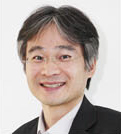Views
| Line 30: | Line 30: | ||
<img src="/mediawiki/uploads/0/0d/Img_slash2.gif">Director of National Creative Research Initiative Center for memory; Editor-in-chief of on-line neuroscience journal, Molecular Brain.</td></tr> | <img src="/mediawiki/uploads/0/0d/Img_slash2.gif">Director of National Creative Research Initiative Center for memory; Editor-in-chief of on-line neuroscience journal, Molecular Brain.</td></tr> | ||
| + | |||
| + | <tr><td height=20 colspan=3> </td></tr> | ||
| + | |||
| + | <tr><td colspan=3><span style="color:#000000;font-size:19px;font-family:Times New Roman;">Graham Leon Collingridge FRS, <font size="3px">MRC Centre for Synaptic Plasticity, U of Bristol</font> <a href="http://www.bris.ac.uk/synaptic/research/pi/GLC_res.html" target="_blank"><font style="font-family:arial;font-size:10px;color:#D9322B">HOMEPAGE</font></a></span></td></tr> | ||
| + | <tr><td height=20 colspan=3> </td></tr> | ||
| + | <tr><td width=121 valign=top><img src="/mediawiki/uploads/0/03/03_img02.jpg"></td> | ||
| + | <td width=20></td> | ||
| + | <td span style="font-family:arial;font-size:12px;color:#414141;"><img src="/mediawiki/uploads/3/3c/Img_slash.gif">Investigating the synaptic basis of learning and memory with an emphasis on the role of glutamate receptors in hippocampal long-term potentiation (LTP) and long-term depression (LTD).<br /> | ||
| + | |||
| + | <img src="/mediawiki/uploads/0/0d/Img_slash2.gif">He established the principle that NMDA receptors trigger plasticity and AMPA receptors mediate a modifiable synaptic response, and this principle has now been extended to many other synapses in the brain and is regarded as one of the most influential discoveries in the field of synaptic function.<br /> | ||
| + | |||
| + | <img src="/mediawiki/uploads/0/0d/Img_slash2.gif">Discovered that NMDA receptor-mediated synaptic transmission is plastic; synaptic plasticity is expressed by changes in AMPA receptor function; both inhibitory and facilitatory autoreceptor mechanisms contribute to the acute and long-term regulation of synaptic transmission.<br /> | ||
| + | |||
| + | <img src="/mediawiki/uploads/0/0d/Img_slash2.gif">High impact publications including Collingridge et al(1983, J of Physiology, over 1,500 citations) and Bliss & Collingridge (1993, Nature, over 5,000 citations).<br /> | ||
| + | |||
| + | <img src="/mediawiki/uploads/0/0d/Img_slash2.gif">Numerous prestigious awards including Elected Fellow, THe Royal Society (2001); Elected President, British Neuroscience Association (2007). The Santiago Grisolia Prize (2008).</td></tr> | ||
| + | |||
| + | |||
| + | <tr><td height=20 colspan=3> </td></tr> | ||
| + | |||
| + | |||
| + | |||
| + | <tr><td colspan=3><span style="color:#000000;font-size:19px;font-family:Times New Roman;">Min Zhuo, <font size="3px">Dept of Physiology, U of Toronto</font> <a href="http://individual.utoronto.ca/zhuo/" target="_blank"><font style="font-family:arial;font-size:10px;color:#D9322B">HOMEPAGE</font></a></span></td></tr> | ||
| + | <tr><td height=20 colspan=3> </td></tr> | ||
| + | <tr><td width=121 valign=top><img src="/mediawiki/uploads/a/a4/03_img03.jpg"></td> | ||
| + | <td width=20></td> | ||
| + | <td span style="font-family:arial;font-size:12px;color:#414141;"><img src="/mediawiki/uploads/3/3c/Img_slash.gif">His lifelong works on the molecular mechanism of chronic pain and the role of ACC in chronic pain is highly creative and exceptional.<br /> | ||
| + | |||
| + | <img src="/mediawiki/uploads/0/0d/Img_slash2.gif">His original findings about the role of CNS on the generation of chronic pain sensation shed light on the field of chronic pain research.<br /> | ||
| + | |||
| + | <img src="/mediawiki/uploads/0/0d/Img_slash2.gif">Expert on brain pharmacology and molecular mechanism of chronic pain (consulting experience with Big Pharmas such as Pfizer).<br /> | ||
| + | |||
| + | <img src="/mediawiki/uploads/0/0d/Img_slash2.gif">Having high-profile publication records (4 Nature, 3 Nature Neuroscience, 5 Neuronn, 1 Science, and total SCI 157 papers within 20 years of research).<br /> | ||
| + | |||
| + | <img src="/mediawiki/uploads/0/0d/Img_slash2.gif">His research goal is to unravel the molecular mechanism of chronic pain and emotion-related brain disorders.<br /> | ||
| + | |||
| + | <img src="/mediawiki/uploads/0/0d/Img_slash2.gif">Founding editor and Editor-in-chief of online neuroscience journal Molecular Pain (Impact factor 4.13, top 20% among Neuroscience journals) and Molecular Brain.<br /></td></tr> | ||
| + | |||
| + | <tr><td height=20 colspan=3> </td></tr> | ||
| + | |||
| + | <tr><td colspan=3><span style="color:#000000;font-size:19px;font-family:Times New Roman;">Sang Jeong Kim, <font size="3px">Dept of Physiology, SNU College of Medicine</font> <a href="http://brain.snu.ac.kr/main.php" target="_blank"><font style="font-family:arial;font-size:10px;color:#D9322B">HOMEPAGE</font></a></span></td></tr> | ||
| + | <tr><td height=20 colspan=3> </td></tr> | ||
| + | <tr><td width=121 valign=top><img src="/mediawiki/uploads/3/39/03_img04.jpg"></td> | ||
| + | <td width=20></td> | ||
| + | <td span style="font-family:arial;font-size:12px;color:#414141;"><img src="/mediawiki/uploads/3/3c/Img_slash.gif">Research focus on the cellular and molecular mechanisms of information storage and its related brain diseases by combining cutting-edge techniques such as patch clamping, Ca imaging, confocal mocroscopy, UVphotolysis and field/single unit recording from isolated neurons, brain slices and in-vivo animals.<br /> | ||
| + | |||
| + | <img src="/mediawiki/uploads/0/0d/Img_slash2.gif">High impact publications in major journals such as Nature, Neuron, and Journal of Neuroscience, etc, making over 300 score of the total impact factor during last five years.<br /> | ||
| + | |||
| + | <img src="/mediawiki/uploads/0/0d/Img_slash2.gif">Published a comprehensive review article in Neuron suggesting that ubiquitous synaptic plasticity is necessary to account for the rich phenomenon of memory storage in the neural network.<br /> | ||
| + | |||
| + | <img src="/mediawiki/uploads/0/0d/Img_slash2.gif">Editorial board of the Journal of Neurophysiology.</td></tr> | ||
| + | |||
| + | |||
| + | |||
| + | <tr><td height=20 colspan=3> </td></tr> | ||
| + | |||
| + | <tr><td colspan=3><span style="color:#000000;font-size:19px;font-family:Times New Roman;">Inah Lee, <font size="3px">PhD, Dept of Brain and Cognitive Sciences, SNU</font> <a href="http://www.inahlee.org/" target="_blank"><font style="font-family:arial;font-size:10px;color:#D9322B">HOMEPAGE</font></a></span></td></tr> | ||
| + | <tr><td height=20 colspan=3> </td></tr> | ||
| + | <tr><td width=121 valign=top><img src="/mediawiki/uploads/9/92/03_img05.jpg"></td> | ||
| + | <td width=20></td> | ||
| + | <td span style="font-family:arial;font-size:12px;color:#414141;"><img src="/mediawiki/uploads/3/3c/Img_slash.gif">His research aim is to elucidate biological mechanisms of episodic memory and rule learning using electrophysiology, behavioral neuroscience, neuropharmacology and computational modeling.<br /> | ||
| + | |||
| + | <img src="/mediawiki/uploads/0/0d/Img_slash2.gif">High impact publications in high-profile journals such as Nature, Nature Neuroscience and Neuron.<br /> | ||
| + | |||
| + | <img src="/mediawiki/uploads/0/0d/Img_slash2.gif">His work in Nature (2004) provided, for the first time, that neurons in hippocampus perform a computational function, pattern completion, that had only been suggested by theoreticians and computational modelers for more than 30 years without any experimental proof.<br /> | ||
| + | |||
| + | <img src="/mediawiki/uploads/0/0d/Img_slash2.gif">His publication record within a short period of time of 7 years is exceptional in the field of systems neuroscience involving animal experiments. | ||
| + | </td></tr> | ||
| + | |||
| + | |||
</table> | </table> | ||
| Line 35: | Line 105: | ||
</td></tr> | </td></tr> | ||
| - | <tr><td height= | + | <tr><td height=50> </td></tr> |
<tr><td><span style="text-transform:uppercase;color:#000000;font-size:18px;font-family:arial;font-weight:bold;color:#D9322B">System and behavior unit</span></td></tr> | <tr><td><span style="text-transform:uppercase;color:#000000;font-size:18px;font-family:arial;font-weight:bold;color:#D9322B">System and behavior unit</span></td></tr> | ||
<tr><td height=20> </td></tr> | <tr><td height=20> </td></tr> | ||
Revision as of 18:45, 28 December 2011
| |||||||||||||||||||||||||||||||||||||||||||||||||||||||||||||||||||||||||||||||












 One of the key leading neurobiologists in Korea with expertise on the molecular mechanism of synaptic plasticity and memory from multiple model systems such as Aplysia and mouse.
One of the key leading neurobiologists in Korea with expertise on the molecular mechanism of synaptic plasticity and memory from multiple model systems such as Aplysia and mouse. His recent work on the molecular, cellular mechanism of synaptic plasticity and fear memory is providing a new view, unveiling novel, original molecular mechanisms of memory.
His recent work on the molecular, cellular mechanism of synaptic plasticity and fear memory is providing a new view, unveiling novel, original molecular mechanisms of memory.



